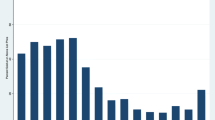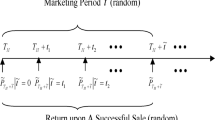Abstract
When house sellers reach the end of a listing contract without a sale they are faced with several decisions. A seller who wants to continue to market the property can leave it on the market, relist the property immediately, or take it off the market for a period of time before relisting it. Research has shown that properties with longer time-on-market may carry a stigma and sell for less. In an attempt to mitigate the negative perception of a house that other buyers appear to have passed by, a seller can have the agent relist the property so it appears as a new listing. If a seller decides to relist the property, the owner also has to decide how long to wait before relisting. We use a hedonic approach to investigate the choices sellers have when deciding whether to relist their property and the impact those decisions have on the property’s selling price. We find that relisting a property results in a higher selling price and that to maximize price, the seller should relist the property with the same agent within 30 days.
Similar content being viewed by others
Notes
We have also estimated our model while leaving out all distressed properties. Removal of the distressed properties does not impact the significance or sign of the coefficients in our model. These results are available upon request.
Details of calculation of the predicted time on the market and Inverse Mills Ratio are presented in the Appendix.
Excluding sales during the first quarter of 2013 when the housing market started to slightly improve has no effect on the results of the analysis.
Recognizing that some properties may have entered the data collection period already in their second listing period, which would lead to underestimation of their total active days on the market, we tested removing all sales in the first two quarters of the data collection period as they would be the most likely to have already been relisted. The results were unchanged.
Benefield and Hardin (2014) use 48 days and Genesove and Mayer (1997) use 4 weeks. Our findings remain unchanged when 30 and 48 days are used instead of 60 days as the criteria for a “new” listing.
To deter the manipulation of time-on-market, the real estate listing services in some states, such as Massachusetts, have changed their policy governing home listings. The revised policies require the time-on-market measure for a house to be an accurate cumulative total that includes previous listings.
References
Anglin, P. M., Rutherford, R., & Springer, T. M. (2003). The trade-off between the selling price of residential properties and time-on-the-market: the impact of price setting. Journal of Real Estate Finance and Economics, 26, 95–111.
Asabere, P. K., & Huffman, F. E. (1993). Price concessions, time on the market, and the actual sale price of homes. Journal of Real Estate Finance and Economics, 6, 167–174.
Asabere, P. K., Huffman, F. E., & Johnson, R. L. (1996). Contract expiration and sales price. Journal of Real Estate Finance and Economics, 13, 255–266.
Benefield, J. D., & Hardin, W. G., III. (2014). Does time-on market measurement matter? Journal of Real Estate Finance and Economics. doi:10.1007/s11146-013-9450-z.
Brastow, R. T., Springer, T. M., & Waller, B. D. (2012). Efficiency and incentives in residential brokerage. Journal of Real Estate Finance and Economics, 45, 1041–1061.
Butler, R. V. (1980). Cross-sectional variation in the hedonic relationship for urban housing markets. Journal of Regional Science, 20, 439–453.
Carrillo, P. E., & Pope, J. C. (2012). Are homes hot or cold potatoes? The distribution of marketing time in the housing market. Regional Science and Urban Economics, 42, 189–197.
Clauretie, T. M., & Daneshvary, N. (2008). Principal-agent conflict and broker effort near listing contract expiration. Journal of Real Estate Finance and Economics, 37, 147–161.
Clauretie, T. M., & Daneshvary, N. (2009). Estimating the house foreclosure discount corrected for spatial price interdependence and endogeneity of marketing time. Real Estate Economics, 37, 43–67.
Corelogic. (2013). Total residential housing sales volume in Atlanta-Sandy Springs-Roswell, GA [Data file].
Daneshvary, N., & Clauretie, T. M. (2013). Agent change and seller bargaining power: a case of principal agent problem in the housing market. Journal of Real Estate Finance and Economics, 47, 416–433.
Daneshvary, N., Clauretie, T., & Kader, A. (2011). Short-term own-price and spillover effects of distressed residential properties: the case of a housing crash. Journal of Real Estate Research, 33, 179–207.
Federal Reserve Bank of St. Louis. (2013a). Employees on nonfarm payrolls in Atlanta-Sandy Springs-Marietta, GA [Data file]. http://research.stlouisfed.org/fred2. Accessed 26 Sept 2013.
Federal Reserve Bank of St. Louis. (2013b). Per capita personal income in Atlanta-Sandy Springs-Marietta, GA [Data file]. http://research.stlouisfed.org/fred2. Accessed 26 Sept 2013.
Federal Reserve Bank of St. Louis. (2013c). Privately owned housing starts authorized by building permits: 1-unit structures for Atlanta-Sandy Springs-Marietta, GA [Data file]. http://research.stlouisfed.org/fred2. Accessed 26 Sept 2013.
Geltner, D., Kluger, B. D., & Miller, N. G. (1991). Optimal price and selling effort from the perspectives of the broker and seller. Real Estate Economics, 19, 1–24.
Haurin, D. (1988). The duration of marketing time of residential housing. AREUEA Journal, 16, 396–410.
Jud, G. D., Seaks, T. G., & Winkler, D. T. (1996). Time on the market: the impact of residential brokerage. Journal of Real Estate Research, 12, 447–458.
Kalra, R., & Chan, K. C. (1994). Censored sample bias, macroeconomic factors, and time on market of residential housing. Journal of Real Estate Research, 9, 253–262.
Kang, H. B., & Gardner, M. J. (1989). Selling price and marketing time in the residential real estate market. Journal of Real Estate Research, 4, 21–35.
Knight, J. R. (2002). Listing price, time on market, and ultimate selling price: causes and effects of listing price changes. Real Estate Economics, 30, 213–237.
Levitt, S. D., & Syverson, C. (2008). Market distortions when agents are better informed: the value of information in real estate transactions. Review of Economics and Statistics, 90, 599–611.
Miceli, T. J. (1989). The optimal duration of real estate listing contracts. Journal of the American Real Estate and Urban Economics Association, 17, 267–277.
Miller, N. G. (1978). Time on the market and selling price. Real Estate Economics, 6, 164–174.
Pennington-Cross, A. (2006). The value of foreclosed property. Journal of Real Estate Research, 28, 193–214.
Rosen, S. (1974). Hedonic prices and implicit markets: product differentiation in pure competition. Journal of Political Economy, 82, 34–55.
Rutherford, R. C., Springer, T. M., & Yavas, A. (2005). Conflicts between principals and agents: evidence from residential brokerage. Journal of Financial Economics, 76, 627–665.
Rutherford, R. C., Springer, T. M., & Yavas, A. (2007). Evidence of information asymmetries in the market for residential condominiums. Journal of Real Estate Finance and Economics, 35, 23–38.
S&P/Case-Shiller Home Price Indices. (2013). Home Price Index for Atlanta, Georgia [Data file]. http://research.stlouisfed.org/fred2. Accessed 26 Sept 2013.
Sirmans, C. F., Turnbull, G. K., & Dombrow, J. (1997). Residential development, risk, and land prices. Journal of Regional Science, 37, 613–628.
Sirmans, G. S., Macpherson, D. A., & Zietz, E. N. (2005). The composition of hedonic pricing models. Journal of Real Estate Literature, 13, 3–43.
Smith, B. C. (2009). Spatial heterogeneity in listing duration: the influence of relative location to marketability. Journal of Housing Research, 18, 151–171.
Springer, T. M. (1996). Single-family housing transactions: seller motivation, price and marketing time. Journal of Real Estate Finance and Economics, 13, 237–254.
Taylor, C. R. (1999). Time-on-the-market as a sign of quality. Review of Economic Studies, 66, 555–578.
Tucker, C., Zhang, J., & Zhu, T. (2013). Days on market and home sales. RAND Journal of Economics, 44, 337–360.
Turnbull, G. K., Dombrow, J., & Sirmans, C. F. (2006). Big house, little house: relative size and value. Real Estate Economics, 34, 439–456.
United States Census Bureau. (2013). Population by MSA: Atlanta-Sandy Springs-Marietta, GA [Data file]. http://www.census.gov/. Accessed 26 Sept 2013.
Waller, B. D., Brastow, R., & Johnson, K. H. (2010). Listing contract length and time on market. Journal of Real Estate Research, 32, 271–288.
Yavas, A., & Yang, S. (1995). The strategic role of listing price in marketing real estate. Real Estate Economics, 23, 347–369.
Author information
Authors and Affiliations
Corresponding author
Appendix
Appendix
Predicted time on the market (\( \widehat{TOM} \)) is estimated using the following equation:
where predicted time-on-market is a function of degree of overpricing, DOP; list price reduction, R; and the atypicality of the house, A. Predicted selling price is used to estimate DOP (see Eq. 3). The results for our intermediate steps are available in Table 5.
The degree of overpricing variable is calculated using the property’s original list price in the first listing contract and predicted selling price. The predicted selling price is obtained using a version of Eq. 1 that is comprised of the physical characteristics of the house, X; distressed conditions surrounding the sale, D; neighborhood characteristics, N; and location and time trend variables representing fixed effects for the exact geographic location and year and season of sale, T.
Previous research finds houses with unusual attributes sell for less and take longer to sell (Haurin 1988; Jud et al. 1996). To capture the atypicality effect we use a model similar to the one presented by Turnbull et al. (2006). They measure the extent to which a given house is either larger or smaller than the average living area in the surrounding neighborhood. We index all houses within a one half mile radius of house i by J. The standardized measure of the relative house size is:
where N j is the number of surrounding houses in the neighborhood J. In order to allow for asymmetric relative house size effects on selling price, we define the relative size variables Larger i and Smaller i as the absolute values of the positive and negative values of Localsize i respectively:
List price reduction, R, is a dummy variable that takes on the value of 1 if the property’s list price was reduced during the final listing period. If the property’s list price at the beginning of the final listing period equals the list price when the property sold, R takes on the value of 0. Knight (2002) reports that a dummy variable representing whether the list price is changed during the listing period is significantly related to time-on-market.
We also estimate a probit model, where the dependent variable is the probability of a property being relisted, to produce the Inverse Mills Ratio (IMR) used in Eq. 1. The probit estimation is calculated using the following equation:
The independent variables in the probit model are degree of overpricing (DOP) as described above and relisted time-on-market (TOM L ). The time-on-market variable used in the probit model is calculated as the number of days the property was actively listed on the MLS. It represents the sum of all the listing contract periods from the starting date of the original listing contract to the time of sale or to the date it was relisted, whichever comes first. In this way, we avoid Benefield and Hardin’s (2014) criticism of using an MLS calculated time-on-market and correctly count the entire initial listing period plus all subsequent relisting periods. We calculate TOM L as follows:
Rights and permissions
About this article
Cite this article
Smith, P.S., Gibler, K.M. & Zahirovic-Herbert, V. The Effect of Relisting on House Selling Price. J Real Estate Finan Econ 52, 176–195 (2016). https://doi.org/10.1007/s11146-015-9503-6
Published:
Issue Date:
DOI: https://doi.org/10.1007/s11146-015-9503-6




